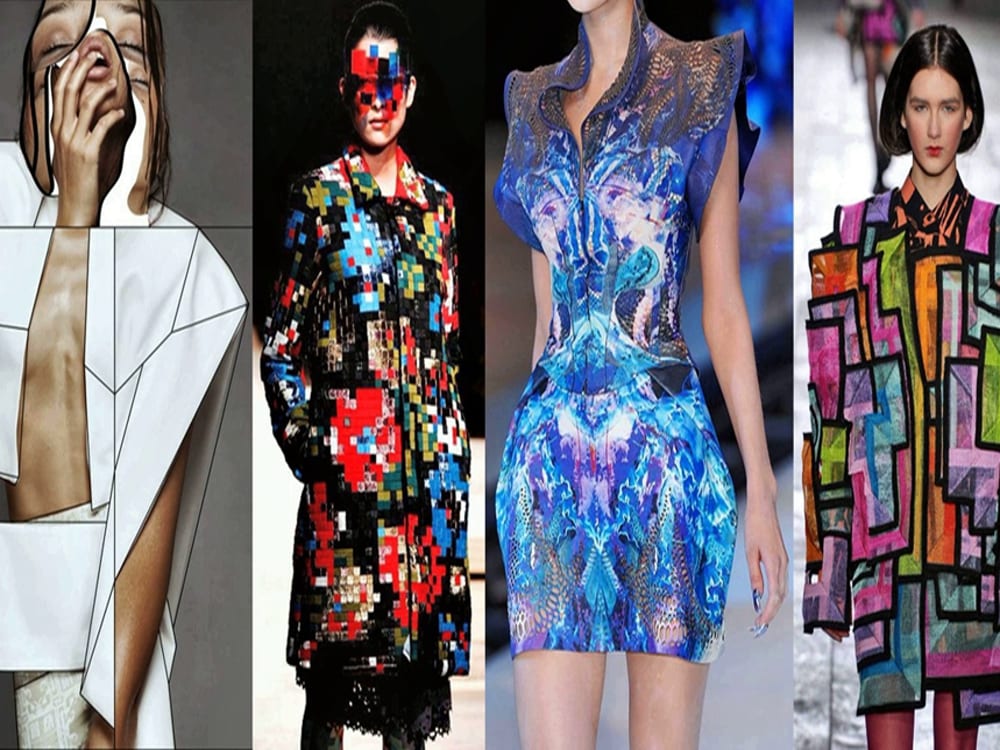How do you imagine the future of fashion, especially now, with the world in lockdown?
Here’s how I see it, based not on COVID-19 but on observing material innovation and the advent of AI for the last decade.
I knew we were approaching a point of physical and digital convergence but didn’t think it would be so fast.
I’ve seen the advent of connected apparel allowing us to interact with the surrounding environment.
Smart clothes that change shape and colour according to the type of activity you are about to embark on.
Clothes that can initiate a safe and eco-friendly decomposing procedure, at the end of their programmed life.
And, this year, the boom of digital garments, as extra visual layers projected in AR environments.
I still remember Stella McCartney’s talk about the need to modernise the industry’s ancient, wasteful, and polluting manufacturing methods:
“The adoption of innovative, cruelty-free and earth-loving materials, coupled with the use of clean manufacturing methods is the key to a better, cleaner future for fashion. It is not a choice but an imperative,” said the British designer at Vogue’s ‘Forces of Fashion Conference’.
It made a lot of sense at that time, as I was seeing how the designer’s futuristic ideas were mapping the values and habits of modern fashion consumers.
And, Stella knew it too: “Buyers have different expectations. To them, technology is sexy and we must approach fashion in a different way, if we want to have a business tomorrow.”
In the light of the latest developments, and COVID-19 accelerating digital adoption, here are the top 10 future of fashion innovations signalling what’s next.
1. Growing Garments – ‘One Size Fits All’

Inspired by the Japanese Origami and called adaptive clothing, Ryan Jasin’s fashion creations ‘grow’ at the same time with the wearer, up to seven sizes.
Winners of the prestigious James Dyson UK award, Ryan’s innovative creations consist of lightweight pleated fabric patterned to make the garments ‘play-proof’, machine-washable, and most important, fully recyclable.
2. Modular Shape Apparel

Creations of Angela Luna, a Parsons School of Design graduate, these shape-changing garments can also be used as a shelter.
The original idea was inspired by refugees and their inability to carry around belongings or having a shelter while travelling thousands of miles.
The concept of garments that have ‘modular shape and adaptive functionality’ has begun to gain traction, with minimalist fashion designers and sustainable fashion labels seeking to minimise manufacturing waste.
3. ‘Flavoured’ Couture
Popularised amongst conscious luxury fashion buyers by Salvatore Ferragamo, through a dedicated capsule collection of t-shirts and scarves, the orange peel fibre has gained increased adoption and use amongst conscious fashion designers from all over the world.
Right now, the garments generate appeal thanks to marketing and one’s imagination, through associations of colour and taste.
However, the next stage is natural scent infusion, that changes according to the time of the day.
4. Body-Nourishing Clothes
Apparel with nutrients that feed the wearer is still a novel concept.
However, a collection made from Algae, finalists of the 2018 H&M Global Innovation Awards, shows there’s massive potential.
The collection was made from Algae-based biodegradable fibres and eco-friendly dyes and was prised for its capability of releasing nutrients, such as vitamins and minerals, onto the wearer’s body.
5. ‘Power’ Garments
Yves Béhar, the founder of ‘FuseProject’, came up with an original idea of power-garments.
Initially, Yves wanted to allow people suffering from muscle dystrophia to function normally.
That is, being able to walk, stand, and be active again for extended periods of time, while also looking good.
Béhar’s concept found a lot of traction in the medical landscape.
However, there’s a new wave of innovative fashion designers showing a growing interest in augmenting the human body with cyborg-like abilities.
6. ‘Connected’ Couture
A similar smart fashion prototype, pictured above in the shape of a cardigan, was ignited by the Dutch designer Pauline van Dongen.
Following on the footsteps of Ivan Poupyrev’s Project Jacquard at Google, Pauline has embedded her ‘Vigour Cardigan’ with flexible sensors.
Made out of conductive yarns, these sensors collect and analyse the wearer’s biometrics, aiming to identify the most efficient exercises and body postures.
Hopefully, future connected garments will ensure – through a direct-line connection with your personal doctor or assistive medical data software – that the paramedics are at your door, long before you start having stroke symptoms.
7. 3D Printed Fashion
Recent waves of innovations targeting the fashion industry have led to an influx of tech-based designers seeking to showcase a new world of techniques, materials, manufacturing methods and creations.
3D printing has become one of the most popular ‘tools’ used by emerging fashion designers.
Iris Van Herpen is the incontestable leader of the movement, thanks to her amazing work at the edge of innovation, and creations out of this world.
The latest developments in 3D printing see a shift towards bio and eco-friendly inks, which could be the beginning of a new era of 3D printed sustainable fashion, for a cleaner industry and a better world.
8. Lab-grown Fashion
Speaking of 3D printing with sustainable materials, so far has been imposible to eradicate the use of leather and fur in fashion.
Leather is deeply embedded in our DNA as a symbols of status since the times of living in caves and wearing our catches as trophies.
Then, ‘thanks’ to the luxury segment, by creating this high quality-leather association in consumers’ minds.
However, the use of leather in fashion is tainted not only by the blood of the animals killed for their skins but also by the significant emissions of greenhouse gases and toxic chemicals involved in mass farming animals, tanning and industrial manufacturing processes.
Finally, there are innovative brands such as Modern Meadow, Bolt Threads, and Furoid TM, creating lab-grown leather, allowing innovative fashion designers to beautifully move to the next stage of sustainable fashion.
9. Augmented Reality Clothing
Initially, the use of augmented reality in fashion has found a lot of traction in the retail side of the landscape.
Gucci’s demo version of a shop for luxury garments remains one of the best examples.
Styled as a dark garden filled with diamonds, attractive models, and pictures on the walls, the platform was designed to showcase the power of experiential e-commerce.
A similar AR experience project was launched by Zara across 120 stores.
The project allowed buyers to hold up their smartphone to the stores’ windows and see AR models come to life, walking around, and wearing the latest trends.
However, while it seems that the adoption of AR in fashion retail is not quite there, the concept of AR has a big role to play in the future of fashion.
In fact, driven by the endeavours of Mathew Drinkwater, Head of Fashion Innovation Agency at London College of Fashion, a new realm of augmented reality garments gains traction fast.
In some ways, it makes a lot of sense as the whole point of fashion in general and luxury fashion, in particular, is to make shoppers dream.
The elusive aspirations of unique attires, ceremonious runway shows, photoshopped models in glossy magazines, all meant to design an unattainable world compared to the one they live in.
For that, AR has the most fitting in the world of fashion, especially now when we are becoming increasingly ‘digitised’.
AR garments have the potential of pushing the boundaries of what we understand fashion to be, by re-computing the nature of who we are and by affecting one’s idea of the self.
AR couture could also give birth to a new concept of self-identity that could bridge the gap between the actual and ideal selves.
However, with unknown and potentially disastrous consequences for both, the self and fashion industry as we know it.
10. Artificial Intelligence
There’s no future of fashion after COVID, without AI.
The use of AI in the fashion industry has already found a home in customer service, demand forecasting, planning, buying, operations automation, supply chain, inventory management.
More recently, we see AI taking over trend spotting, product design, and high-level customisation.
However, YOOX’s latest endeavour – 8 an AI designed fashion label – is beyond the traditional areas of machine tasks.
AI as a fashion designer is a new role that touches the creative realm, blurring the line between technology, human, and creativity.
The first question that comes to mind is, will consumers prefer AI-made or human-made fashion?
Traditionally, a human-made garment encapsulates craftsmanship, heritage, and history.
It comprises the experiences, memories, life choices, and even the emotions of its creator.
However, in the case of an omnipotent and salient AI, the ‘designer’ has access to the history of the entire humanity.
It can draw inspiration from humanity’s history, from our ‘evolutionary struggles’, as depicted in science, to music and art.
It has access to all materials in the world, able to compare and select the most suitable elements for its intended creations.
It can also decide on the most efficient manufacturing technologies…
And, to complicate things a bit further, who owns the rights of its, his, or her creations?
Which takes me to the question, is personhood the next step for AI?
But, that’s a different story, for a different article.
Weekly Newsletter. Sign Up Now!
Celebrities, designers, and latest news in sustainable fashion.
WTVOX – ‘Voicing the Future of Fashion’
For lightning-quick updates delivered to your inbox subscribe to our newsletter.
For the latest innovations in fashion, beauty, and lifestyle follow us on social media: Instagram, LinkedIn, Facebook, Twitter.
And, to interact with thousands like you, join your tribe on the Future of Fashion Group.






